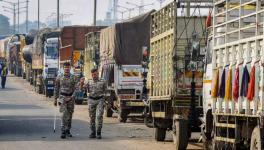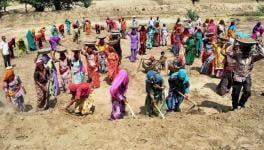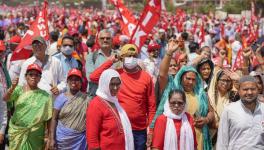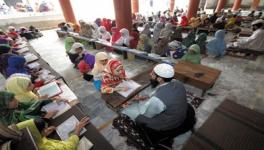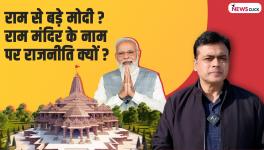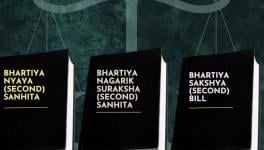Demonetisation Disaster to Intensify Further
Demonetisation has adversely impacted manufacturing and agricultural growth. The disruption to the economy will be such that there will be possibly, no growth in this last quarter of the year and actually a shrinking of the economy. Most active segments of the population who constitute the ‘base of the pyramid’ use currency to meet their transactions. For instance the daily wage earners, other labourers, and small traders, who reside out of the formal economy, use cash frequently. These sections will lose income due to demonetisation. Cash stringency will compel firms to reduce labour cost and thus reduce income to the poor working class. There will be a trickle up effect of the liquidity chaos to the higher income people with time. When liquidity shortage strikes, it is consumption that is going to be adversely affected first. Reduced consumption, income and investment may bring down India’s GDP growths as the liquidity impact itself will last three - four months at the least. Prof. Surajit Mazumdar and prof. Vikas Rawal talk about the issue more extensively.
Rough Transcript:
Prabir: Hello and welcome to Newsclick. This programme with The Real News. Today we will discuss the effect of the demonetization, what we call demonetization is really deflating the economy by huge amount. We have with us Surajit Mazumdar and Vikas Rawal and both are economists and we will discuss what's the likely impact on the economy. First, quick question. How much of the economy has been remonetized after 86 percent of the cash is drawn?
Surajit: Well, according to the latest figures available till 27th while about fourteen and a half lakh crores of currency that was in use was deactivated by the decision of the 8th, only about two and a half lakh crores have actually gone back in. It is still about twelve lakh crores less than what was in circulation in the economy on the 8th. So, less than a third of the total currency that was in use on the 8th is in use at the moment.
Prabir: How much of the money that was withdrawn has now been put back into the economy? Surajit: Around 17 percent has been put back.
Prabir: So at the moment 83 percent is still out of the amount that was originally withdrawn. So what is the likely impact on the economy?
Surajit: Well since less than a fifth has been put back into circulation, it would mean that even if you are able to replace at the same rate as you are doing right now, it would take hundred days, more than three and a half months for that replenishment to take place. But however, you started with a situation where you already had some more new currency printed. Now, adding is something which has to be printed over this period and it does not seem that it is going to be possible to print out all the required currency within this particular period. So it's more than three and a half months is what you are going to face this problem of shortage of currency in the economy.
Prabir: Really, the effect has been much more on the rural economy, agrarian economy. You tell us what is the situation particularly in view of the fact that this is also the sowing season.. So the effect of lack of liquidity would be really more.
Vikas: So actually you already had rural economy under huge distress because of two years’ of successive drought, all the whole context of withdrawal of public investment and so on and then comes the demonetization. Now, demonetization actually comes particularly at a bad time foragriculture because as you said Kharif harvest just got over. It was time for Rabi sowing. Now such a thing typically would set in motion very complex dynamic in the rural economy pushing people into distress,pushing people into indebtedness and deeply affecting agricultural workers.
Prabir: One part of it is agriculture what happens to the farming community itself but it is also a large part of the rural economy is also informal in other ways. In fact, that's also been hit because it appears that the rural banks either don't have cash or really they are catering to a much larger set of people and people have to walk long distances to come to the bank and not getting the money. So is it also the rest of the rural economy?
Vikas: You basically have a situation where agricultural workers, poor peasants are being paid in old currency which then they go to Mahajans to convert at a commission of anything from 25 percent to 40 percent. As a result this basically means the effective wages for, their incomes have taken a huge hit.
Prabir: So there is a double blow to the poor. One in terms of farm incomes, agricultural laborsmall peasant and so on and the second the family members who are actually supplementing this income by working in the towns. They also have also seem to have gone back because no work is available in the towns because again, same reason. Is it also hitting?
Vikas: Absolutely, informal labor, both rural and urban, agricultural and non-agriculture, and construction would be one major sector because construction over the last ten years or so has really emerged as a sector that absorbs a lot of residual labor. Suddenly, all of that just comes to a standstill. There is no work, people go back. The other thing is that it is incredible how little we think of rural India. Tthink of public distribution system. How do people go and buy grain now because you don't have money. You don't have cash. You have done something with petrol pumps. Petrol pumps are allowed to take Rs. 500 rupee notes, what about ration shops?. Nobody has even talked about ration shops.
Prabir: When it comes to the industrial sector, the other sectors of the economy, what has been the impact?
Surajit: The process that is at work is essentially one in which once you have withdrawn so much currency from circulation, spending activity is boumd to come down. So its first effect is whatever is produced and yet to be sold, doesn't get sold. The industrial sector always has stocks of goods that are produced which have to be sold. So that process of that movement stops. The process of producing also gets disrupted because A, goods are not moving out. B, because you are not in a position often to purchase all the inputs if you require currency, particularly in the unorganized manufacturing activities, there would be large use of currency. The organized sector may not be using so much currency but they also need currency to pay wages and for various other kinds of activities required for daily production activity. There will be a loss or work where people on the one hand face the problem, the process by which they receive money to spend which is their work, that process gets disrupted. They are not receiving money as income and they are also not able to spend the money that they already have earned.
Prabir:You take a whole bunch of industries in and around the country :Tirupur,, the textile and the garment manufacturing sector all of them seem to be slowing down. It was felt that may be after two, three weeks things would become normal therefore, they will not send people back immediately but now, all of them seem to be closing down.
Surajit: You see, if you have this process where the inability to spend the money that you have leads to a destruction of production and and the process by which income is generated, then the following effect of that is that the income that people would spend has not got created. The consequences for demand and not just immediate effects but the loss of income that people are sufferingthat will have an effect on demand even beyond this immediate period.
Prabir: A quick question to both of you. What is the likely impact in the next six months in the economy?
Surajit: What the effect on the calculated GDP will be I cannot say. Because our GDP figures themselves are now very suspect. So I can't say what's going to happen on that. But if for a three month period, which is one quarter, if you have roughly ten percent of economic activity disrupted, that's two and a half percent of your annual GDP gone. Of course, the effects of that go beyond that. When economic activity is disrupted, lots of small units get disrupted, shortage of cash will lead to various ways to make up for that, people will go into debt. The effect therefore, on the production process will continue way beyond these three or four months. If there is a disruption of economic activity, there is no automatic process in the kind of economy we have, of bringing it back on track. So it is not that if you disrupt it will just bounce back tomorrow once you put the money back in.
Vikas: Now, what's going to happen effectively is to a large extent people are going to have to borrow to survive during these months. So you go to your grocery store and you basically pick up goods on credit. When things get remonetized, eventually people would have to pay that debt. What happens to the prices then, because you have not had your production.
Prabir: So what explains this kind of decision. Do you think it is essentially to force the economy to move into the Pay TM kind of channels which Modi supports?
Surajit: Even if one is thinking in terms of moving towards the cashless economy and promoting other things, the infrastructure required for that and the conditions required for that simply do not exist in the Indian economy as of now. We don't have those conditions even in much more advanced economies forget about India where so many people don't have bank accounts, banks are very far away and even there is this digital divide, people don't have access to all the equipment required for that and nor they can afford it. So the large number of transactions, their size, magnitude and nature is such that cash is the more convenient way, more economical way of undertaking payment. So it is as if you don't have wherewithal at the moment for a cashless economy.
Vikas: The other thing is that it really reflects somewhere how little the powers that be know what India is. It's obscene when you hear on the radio and television an advertisement telling people pick up the smart phone and use something like Pay TM and pay. Do they know what they are talking about? Do they know what destitution and poverty, poor working classes of this country live in? Do they have any idea what this country is about?
Prabir: Okay, on that note that the Indian people are going to be hit are continuing to be, this hit is going to continue for months to come. The economy is going to take a hit. What benefits it will have for the ruling dispensation we are yet to see. Thank you very much for joining us in Newsclick. Do keep watching Newsclick for further episodes on this issue.
DISCLAIMER: Please note that transcripts for Newsclick are typed from a recording of the program. Newsclick cannot guarantee their complete accuracy.
Get the latest reports & analysis with people's perspective on Protests, movements & deep analytical videos, discussions of the current affairs in your Telegram app. Subscribe to NewsClick's Telegram channel & get Real-Time updates on stories, as they get published on our website.












